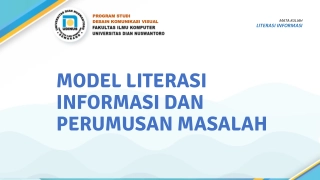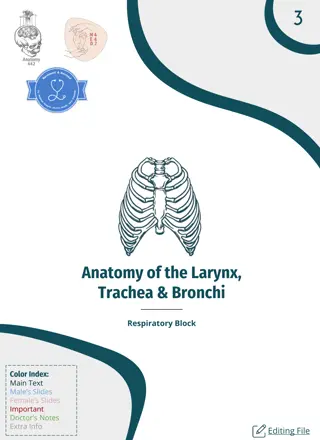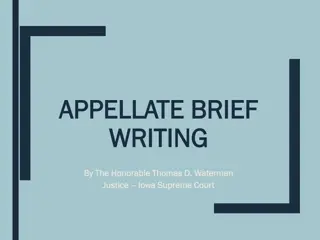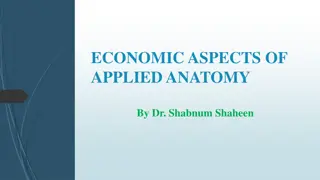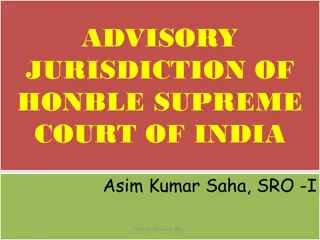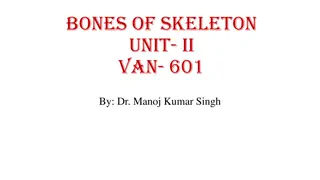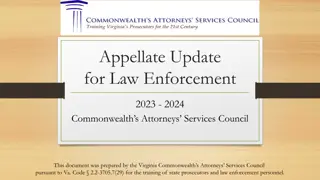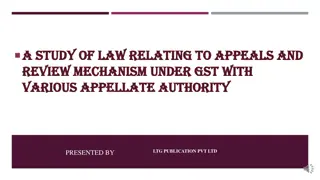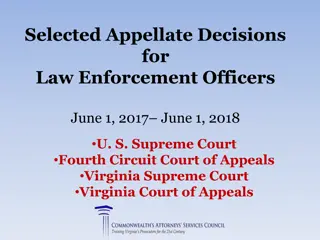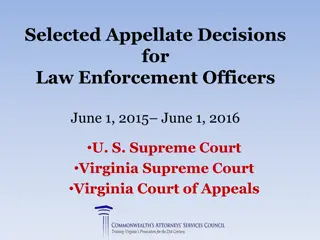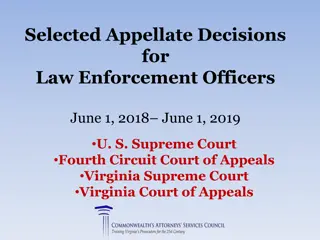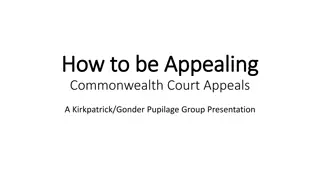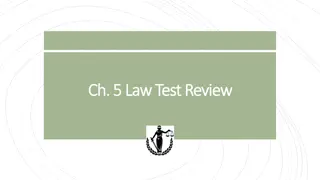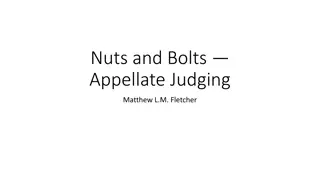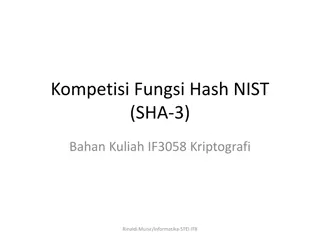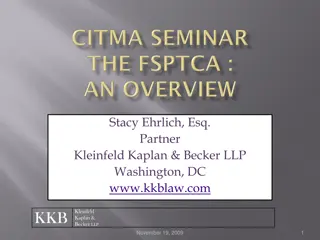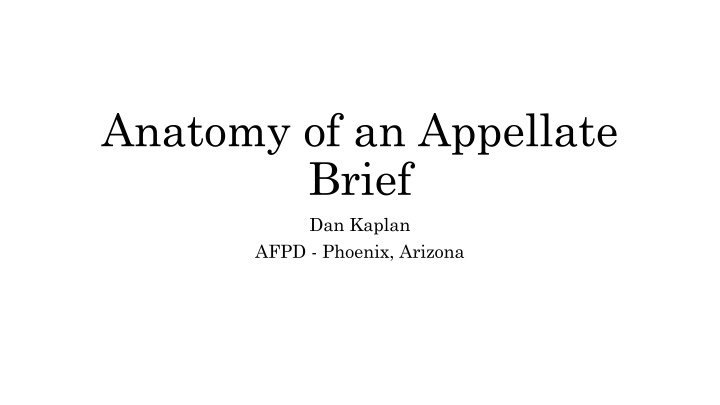
Crafting Compelling Appellate Briefs: A Guide to Effective Storytelling
Explore the art of storytelling in appellate briefs through narrative-driven examples, character development, active voice usage, and the delicate balance of presenting facts. Learn how to elevate your legal writing by infusing heart and emotion into your arguments while skillfully navigating challenging case details.
Uploaded on | 1 Views
Download Presentation

Please find below an Image/Link to download the presentation.
The content on the website is provided AS IS for your information and personal use only. It may not be sold, licensed, or shared on other websites without obtaining consent from the author. If you encounter any issues during the download, it is possible that the publisher has removed the file from their server.
You are allowed to download the files provided on this website for personal or commercial use, subject to the condition that they are used lawfully. All files are the property of their respective owners.
The content on the website is provided AS IS for your information and personal use only. It may not be sold, licensed, or shared on other websites without obtaining consent from the author.
E N D
Presentation Transcript
Anatomy of an Appellate Brief Dan Kaplan AFPD - Phoenix, Arizona
Storyless (i.e., heartless) Statement of Facts The government charged Defendant with At trial, Officer Johnson testified Next, Agent Smith testified Finally, Defendant testified
Storytelling Statement of Facts John s crime began and ended when, on the afternoon of Sunday, February 3, 2008, he placed a batch of Priority Mail parcels in a mailbox in Glendale, Arizona. The parcels did not contain explosives or poisons, real or counterfeit. They contained speech.
The government first called Ms. Jones to testify on the second day of trial. She testified that she fell down behind the vehicle while Mr. Jones was backing up.
The government first called Ms. Jones to the stand on the second day of trial. She testified that she fell down behind the vehicle while Mr. Jones was backing up. The prosecutor accused Ms. Jones of perjury, and suggested that the court appoint a lawyer to represent her. The next day, the prosecutor called Ms. Jones to the stand again and asked her whether she wanted to correct her testimony
Naming the characters Defendant
Passive v. Active Voice Mr. Jones wife received road rash -type abrasions when a Ford Explorer he was driving backed up while she was behind it.
Bad Facts Omit? Footnote? Finesse
Passive Voice Mr. Jones wife received road rash -type abrasions when a Ford Explorer he was driving backed up while she was behind it.
Although Although Officer Miller claimed that safety considerations prompted him to search Mr. Smith, he articulated no basis for believing that Mr. Smith was armed or posed a danger.
Reverse-primacy-and-recency After Mr. Smith presented two credit cards, which were declined, he left the store.
Identify as assertions Officer Miller testified that he was concerned that Mr. Smith was reaching for a weapon.
Unnecessary Facts On July 12, 2017 . . .
Maintaining the Heart-Brain Connection Don t tell show.
Structuring Issues: Decision Tree* I. Judgment of Acquittal I. New Trial I. Resentencing * Jurisdiction appeal waiver, time bar, mootness; preservation issues
Structuring Analysis: Clear Promises, Clearly Kept The search was unlawful for three reasons. First, Second, Finally,
Structuring Dependence and Independence of Arguments Stressing the independence of your arguments: Even if the search was still unlawful Assuming, arguendo, The search suffered from three independently-fatal flaws. Stressing the interdependence of the government s arguments: The government s position would be valid only if and and
Ergo? Because , the Court should ____________ Reverse for entry of judgment of acquittal Reverse and remand for a new trial Vacate the sentence and remand for resentencing Other?
Jabba the Hut Statement of Facts 1. The Arrest 2. The Trial 3. The Sentencing Argument 1. The search was unlawful 2. The Sentence was unreasonable
Statement of Facts 1. After James Smith was injured in the course of a fight with Mr. Williams, the government charged Mr. Williams with two counts of assault. 2. Mr. Williams asked the district court to give the jury a self- defense instruction, but the court refused. 3. Two witnesses described portions of the fight between Mr. Williams and Mr. Smith, but did not describe how Mr. Smith was injured. Argument 1. The district court erred by refusing to give the jury a self- defense instruction.
Using captions to highlight good facts and good law In the Statement of Facts: 1. After 20 minutes of running checks, Officer Miller knew that he didn t have anything on Mr. Smith, but continued the detention. In the Argument: 1. The agents failed to diligently pursu[e] a means of investigation that was likely to resolve their suspicions very soon.
Whether the district court erred in denying defendants request for a self-defense instruction.
Refusal to instruct jury on self-defense. A district court commits per se reversible error when it refuses a criminal defendant s request that it instruct the jury on a defense that is supported by law and has some foundation in the evidence. It was undisputed here that Mr. Jones requested self-defense instruction was supported by law, and the trial evidence indicated that Mr. Smith was injured, likely by a knife, during a fight with Mr. Jones, but did not establish who introduced the knife into the fight or how Mr. Smith was injured. Did the district court err in refusing to give the jury a self-defense instruction?
Refusal to instruct jury on self-defense. (Identify the issue at a glance. )
A district court commits per se reversible error when it refuses a criminal defendant s request that it instruct the jury on a defense that is supported by law and has some foundation in the evidence. (Identify the rule governing the issue.)
It was undisputed here that Mr. Jones requested self- defense instruction was supported by law, and the trial evidence indicated that Mr. Smith was injured, likely by a knife, during a fight with Mr. Jones, but did not establish who introduced the knife into the fight or how Mr. Smith was injured. (Summarize undisputed facts relating to the issue.)
Did the district court err in refusing to give the jury a self- defense instruction? (Identify the ultimate question, with standard of review.)
Introduction John Miller is a 39-year-old construction worker, field laborer, father of three, and member of the Gila River Indian Community, which occupies a reservation just south of Phoenix, Arizona. In early 2014 Mr. Miller had a fight with his father s girlfriend s son Albert Jones, during which Mr. Jones sustained a wound to the side of his head. The government charged Mr. Miller with assault resulting in serious bodily injury and assault with a dangerous weapon. The prosecutor struck an Asian-American from the jury over Mr. Miller s objection, explaining (among other things) that the juror volunteered at science fiction conventions which leads to giving more weight to fantasy rather than fact. Mr. Miller s defense at trial was self-defense, but the district court refused to give the jury a self-defense instruction. Over Mr. Miller s objection, the district court permitted the government to state in its closing argument that one of its witnesses testified that he saw Mr. Miller slashing at Mr. Jones with a shiny object, although the witness only testified to Mr. Miller [t]rying to get Mr. Jones with something shiny, evidently from the opposite side of a door. The jury convicted Mr. Miller of assault resulting in serious bodily injury but acquitted him of assault with a dangerous weapon, and the district court sentenced him to 108 months of incarceration. Mr. Miller now appeals.
John Miller is a 39-year-old construction worker, field laborer, father of three, and member of the Gila River Indian Community, which occupies a reservation just south of Phoenix, Arizona. (Humanize the client with facts from the Presentence Report.)
In early 2014 Mr. Miller had a fight with his fathers girlfriend s son Albert Jones, during which Mr. Jones sustained a wound to the side of his head. The government charged Mr. Miller with assault resulting in serious bodily injury and assault with a dangerous weapon. (Identify the factual core of the case)
The prosecutor struck an Asian-American from the jury over Mr. Miller s objection, explaining (among other things) that the juror volunteered at science fiction conventions which leads to giving more weight to fantasy rather than fact. . . . (Flag the facts that relate to your issues.)
The jury convicted Mr. Miller of assault resulting in serious bodily injury but acquitted him of assault with a dangerous weapon, and the district court sentenced him to 108 months of incarceration. Mr. Miller now appeals. (Identify the case s procedural path to the circuit court.)


